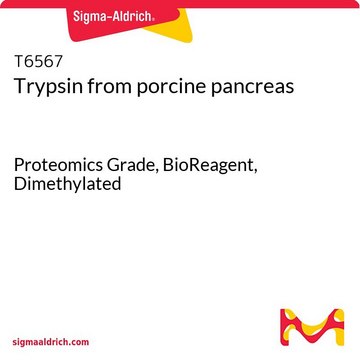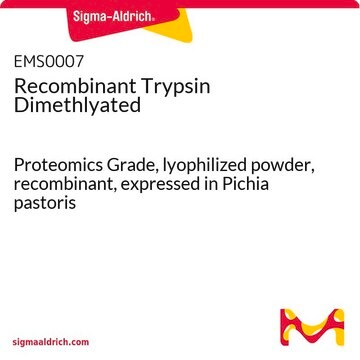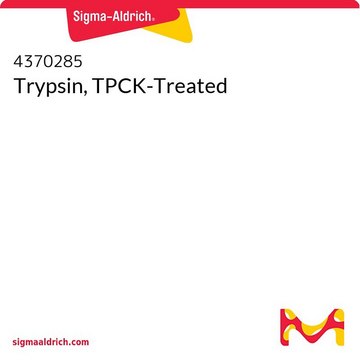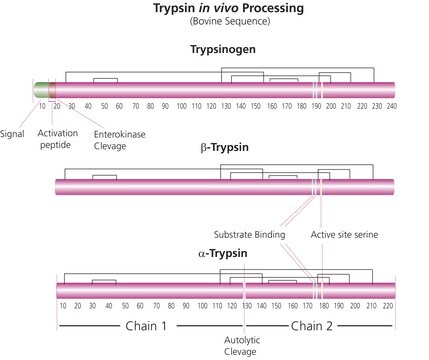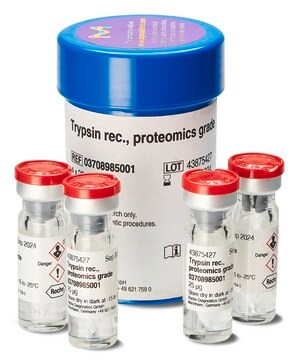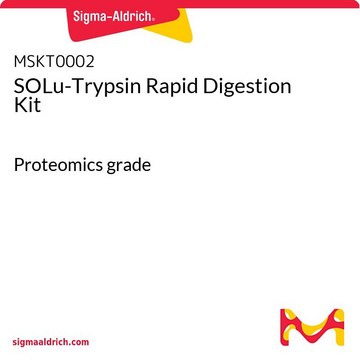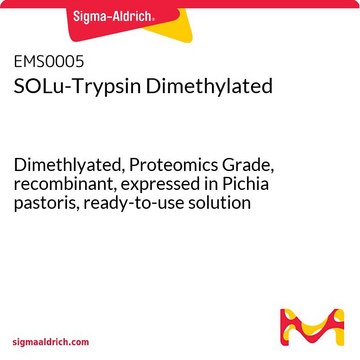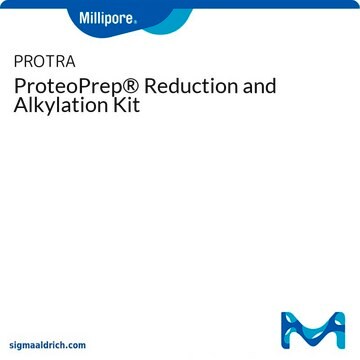T7575
Trypsin Singles, Proteomics Grade
Synonym(s):
Proteomics grade, Trypsin, TPCK treated
Sign Into View Organizational & Contract Pricing
All Photos(1)
About This Item
UNSPSC Code:
12352204
NACRES:
NA.56
Recommended Products
grade
Proteomics Grade
Quality Level
form
ready-to-use solution
specific activity
≥10,000 BAEE units/mg protein
mol wt
average mol wt 23.29 kDa
optimum pH
~8.0
storage temp.
2-8°C
General description
Experience all of the advantages of Proteomics Grade Trypsin in a convenient, single-use 1 μg package.
Trypsin Singles, Proteomics Grade exhibit excellent proteolytic efficiency, generating more tryptic peptides leading to greater sequence coverage of your peptide of interest. Mass spectra are significantly simplified due to the reduced number of interfering autolytic peaks and their ambiguous adducts. Proteomics Grade Trypsin has been extensively purified from porcine pancreas to enable accurate and precise cleavage on the carboxylic side of Arg and Lys residues. The enzyme has been exhaustively processed by reductive methylation to minimize autolysis and chymotryptic activity has been quenched by TPCK treatment. Further purification steps including affinity chromatography and drying from dilute acid produce a highly purified, high specific activity trypsin purposely suited for the demanding criteria of proteomics research, and designed to function in either solution or gel-based digests.
Trypsin Singles, Proteomics Grade exhibit excellent proteolytic efficiency, generating more tryptic peptides leading to greater sequence coverage of your peptide of interest. Mass spectra are significantly simplified due to the reduced number of interfering autolytic peaks and their ambiguous adducts. Proteomics Grade Trypsin has been extensively purified from porcine pancreas to enable accurate and precise cleavage on the carboxylic side of Arg and Lys residues. The enzyme has been exhaustively processed by reductive methylation to minimize autolysis and chymotryptic activity has been quenched by TPCK treatment. Further purification steps including affinity chromatography and drying from dilute acid produce a highly purified, high specific activity trypsin purposely suited for the demanding criteria of proteomics research, and designed to function in either solution or gel-based digests.
Application
Trypsin Singles, Proteomics Grade have been used for protein digestion to analyse generated peptides via MALDI-TOF MS (matrix assisted laser desorption ionization-time of flight mass spectrometry). It has been used for the digestion of proteins to analyse generated peptides via LC-MS (liquid chromatography–mass spectrometry)/MS.
Features and Benefits
- Convenient, single-use 1 μg size
- Eliminates repetitive pipetting
- Reductively methylated to minimize autolytic activity
- TPCK treated to quench chymotryptic activity
- Extensively purified
related product
Product No.
Description
Pricing
Signal Word
Danger
Hazard Statements
Precautionary Statements
Hazard Classifications
Acute Tox. 4 Dermal - Acute Tox. 4 Inhalation - Acute Tox. 4 Oral - Eye Irrit. 2 - Flam. Liq. 2 - Resp. Sens. 1 - Skin Irrit. 2 - STOT SE 3
Target Organs
Respiratory system
Storage Class Code
3 - Flammable liquids
Choose from one of the most recent versions:
Already Own This Product?
Find documentation for the products that you have recently purchased in the Document Library.
Customers Also Viewed
Arun K Ramani et al.
Molecular systems biology, 4, 180-180 (2008-04-17)
The human protein interaction network will offer global insights into the molecular organization of cells and provide a framework for modeling human disease, but the network's large scale demands new approaches. We report a set of 7000 physical associations among
Daniel W Udwary et al.
Applied and environmental microbiology, 77(11), 3617-3625 (2011-04-19)
Bacteria of the genus Frankia are mycelium-forming actinomycetes that are found as nitrogen-fixing facultative symbionts of actinorhizal plants. Although soil-dwelling actinomycetes are well-known producers of bioactive compounds, the genus Frankia has largely gone uninvestigated for this potential. Bioinformatic analysis of
Michael Costanzo et al.
Science (New York, N.Y.), 327(5964), 425-431 (2010-01-23)
A genome-scale genetic interaction map was constructed by examining 5.4 million gene-gene pairs for synthetic genetic interactions, generating quantitative genetic interaction profiles for approximately 75% of all genes in the budding yeast, Saccharomyces cerevisiae. A network based on genetic interaction
Tiziana Cabras et al.
Molecular & cellular proteomics : MCP, 9(10), 2099-2108 (2010-06-30)
The acidic soluble fraction of whole saliva of type 1 diabetic children was analyzed by reversed phase (RP)(1)-HPLC-ESI-MS and compared with that of sex- and age-matched control subjects. Salivary acidic proline-rich phosphoproteins (aPRP), histatins, α-defensins, salivary cystatins, statherin, proline-rich peptide
Identification of protein binders in artworks by MALDI-TOF/TOF tandem mass spectrometry.
Tripkovic T, et al.
Talanta, 113, 49-61 (2013)
Our team of scientists has experience in all areas of research including Life Science, Material Science, Chemical Synthesis, Chromatography, Analytical and many others.
Contact Technical Service